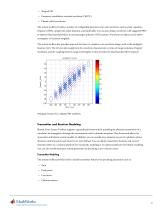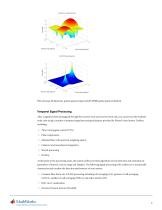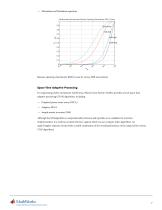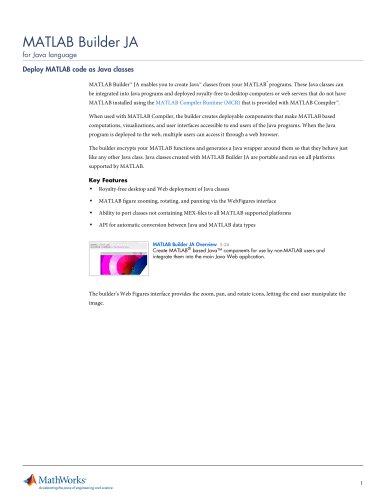 Website:
The MathWorks
Website:
The MathWorks
Catalog excerpts

Phased Array System Toolbox Design and simulate phased array signal processing systems Phased Array System Toolbox™ provides algorithms and tools for the design, simulation, and analysis of phased array signal processing systems. These capabilities are provided as MATLAB® functions and MATLAB System objects™. The system toolbox includes algorithms for waveform generation, beamforming, direction of arrival estimation, target detection, and space-time adaptive processing. The system toolbox lets you build monostatic, bistatic, and multistatic architectures for a variety of array geometries. You can model these architectures on stationary or moving platforms. Array analysis and visualization apps help you evaluate spatial, spectral, and temporal performance. The system toolbox lets you model an end-to-end phased array system or use individual algorithms to process acquired data. Key Features ▪ Monostatic and multistatic radar system modeling, including point targets, free-space propagation, surface clutter, and barrage jammer ▪ Modeling of sensor arrays and subarrays with arbitrary geometries ▪ Polarization and platform motion specification for arrays and targets ▪ Synthesis and analysis of continuous and pulsed waveforms ▪ Broadband and narrowband digital beamforming, including MVDR/Capon, LCMV, time delay, Frost, and subband phase shift ▪ Direction of arrival algorithms, including monopulse, beamscan, MVDR, root MUSIC, and ESPRIT ▪ Algorithms for TVG, pulse compression, coherent and noncoherent integration, CFAR processing, plotting ROC curves, and estimating range and Doppler ▪ Space-time adaptive processing (STAP), including sample matrix inversion (SMI), and angle-Doppler response visualization The system toolbox includes examples that provide a starting point for implementing user-defined phased array systems. Phased Array Design and Analysis Phased Array System Toolbox enables you to model and analyze the behavior of common array geometries and user-defined array geometries. Common array geometries include: ▪ Uniform linear array (ULA) ▪ Uniform rectangular array (URA) ▪ Conformal array You can define your own array geometry by specifying the number of elements, the element spacing, and each element’s position and orientation in 3D space. The individual element response and radiation pattern can be isotropic, cosine shaded, or specified by your own 3D pattern. Your response and radiation pattern can be either described by an ideal analytic function or defined from measured data. You can apply shading (tapering) across the entire array. You can also define multiple element patterns in an array to model an inhomogeneous array.
Open the catalog to page 1
With the system toolbox, you can model common antenna and microphone elements. In a custom antenna or microphone, you can specify wideband, frequency-dependent patterns. You can also specify polarization in polarization-capable antenna elements, such as Dipole or custom antennas. The system toolbox provides tools to visualize and analyze the radiation pattern of individual elements or of the whole array in aggregate. The visualization can be inspected in rectangular, spherical, and u/v space. With the tools, you can measure or visualize: ▪ Array geometry ▪ Array gain ▪ Array response ▪...
Open the catalog to page 2
■ Frequency modulation constant waveform (FMCW) ■ Phased coded waveforms The system toolbox provides a number of configurable parameters for each waveform, such as pulse repetition frequency (PRF), sample rate, pulse duration, and bandwidth. You can also design waveforms with staggered PRFs to address blind-speed problems in moving target indicator (MTI) systems. Waveform envelopes can be either rectangular or Gaussian weighted. The system toolbox also provides apps and functions to visualize your waveform design, such as the ambiguity function (AF). The AF provides insight into the...
Open the catalog to page 3
Receiver Modeling You can also model the reception of a signal at the receiver array to accommodate a variety of situations. You can control the receiver array’s behavior using the following attributes: ▪ Narrowband or broadband model ▪ Far-field or near-field model ▪ Array shading ▪ Platform motion After a signal has been received across the array elements, you can configure the receiver front-end model parameters such as: ▪ Gain ▪ Loss factor ▪ Noise bandwidth ▪ Noise figure ▪ Reference temperature You can also configure receiver models for either coherent or noncoherent processing....
Open the catalog to page 4
Spatial Signal Processing Digital Beamforming Beamforming is a fundamental spatial signal processing operation of a phased array system. Phased Array System Toolbox supports 1D and 2D beamforming techniques, as well as conventional and adaptive beamforming techniques. The system toolbox provides the Capon algorithm, a common adaptive beamformer for suppressing interference, and the linearly constrained minimum variance (LCMV) beamformer, for avoiding situations where self-nulling can occur. For broadband signals, the system toolbox offers adaptive algorithms such as the Frost and time delay...
Open the catalog to page 5
3-0 Seamscan Spalial Sped rum Elevation Anglt [deques] Azimuth Angle [degrees] 2-D MVDR Spaliat Spectrum Plots showing 2D beamscan spatial spectrum (top) and 2D MVDR spatial spectrum (bottom). Temporal Signal Processing After a signal has been propagated through the receiver array and receiver front end, you can process the resultant radar cube using a number of temporal signal processing techniques provided by Phased Array System Toolbox, ■ Time-varying gain control (TVG) ■ Matched filter with spectrum weighting option ■ Coherent and noncoherent integration At this point in the processing...
Open the catalog to page 6
Albersheim and Shnidman equations Nonfluctuating Noncoherent Receiver Operating Characteristic (ROC) Curves Receiver operating characteristic (ROC) curves for various SNR environments. Space-Time Adaptive Processing For suppressing clutter and jammer interference, Phased Array System Toolbox provides several space-time adaptive processing (STAP) algorithms, including: ■ Displaced phase center array (DPCA) ■ Sample matrix inversion (SMI) Although the SMI algorithm is computationally intensive and typically not a candidate for real-time implementation, it is useful as an ideal reference,...
Open the catalog to page 7All The MathWorks catalogs and technical brochures
-
MATLAB Production Server
6 Pages
-
Database Toolbox
4 Pages
-
MATLAB Report Generator
4 Pages
-
Stateflow
8 Pages
-
SimEvents
7 Pages
-
SimDriveline
7 Pages
-
SimHydraulics
7 Pages
-
SimPowerSystems
8 Pages
-
Simulink Control Design
5 Pages
-
Aerospace Blockset
5 Pages
-
SimRF
6 Pages
-
Simulink Coder
6 Pages
-
Embedded Coder
8 Pages
-
Simulink PLC Coder
4 Pages
-
Fixed-Point Designer
9 Pages
-
MATLAB Coder
5 Pages
-
Simulink 3D Animation
10 Pages
-
Gauges Blockset
2 Pages
-
Simulink Report Generator
3 Pages
-
Polyspace Bug Finder
6 Pages
-
global-optimization-toolbox
10 Pages
-
OPC Toolbox
5 Pages
-
Simulink Design Verifier
7 Pages
-
Simulink Design Optimization
10 Pages
-
Filter Design HDL Coder
5 Pages
-
Bioinformatics Toolbox
9 Pages
-
SimBiology
6 Pages
-
Computer Vision System Toolbox
10 Pages
-
DSP System Toolbox
11 Pages
-
Fuzzy Logic Toolbox
5 Pages
-
Polyspace Client for C/C++
5 Pages
-
xPC Target
5 Pages
-
SimMechanics
7 Pages
-
Simscape
7 Pages
-
Simulink
6 Pages
-
Data Acquisition Toolbox
8 Pages
-
Image Processing Toolbox
7 Pages
-
Signal Processing Toolbox
10 Pages
-
Control System Toolbox
6 Pages
-
Symbolic Math Toolbox?
6 Pages
-
Parallel Computing Toolbox?
7 Pages
-
MATLAB®
6 Pages
-
Mapping Toolbox 3.2
7 Pages
-
Instrument Control Toolbox
7 Pages
-
Optimization Toolbox 6.0
14 Pages
Archived catalogs
-
MATLAB Release Notes
505 Pages
-
C and Fortran API Reference
263 Pages
-
External Interfaces
649 Pages
-
Function Reference: Volume 3 (P-Z)
1696 Pages
-
Function Reference: Volume 2 (F-O)
1568 Pages
-
Function Reference: Volume 1 (A-E)
1298 Pages
-
Creating Graphical User Interfaces
520 Pages
-
3-D Visualization
212 Pages
-
Graphics
667 Pages
-
MATLAB Programming Tips
66 Pages
-
Programming Fundamentals
840 Pages
-
Data Analysis
220 Pages
-
Mathematics
316 Pages
-
MATLAB® Getting Started Guide
250 Pages





































































